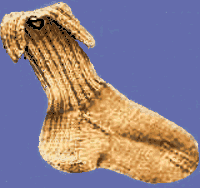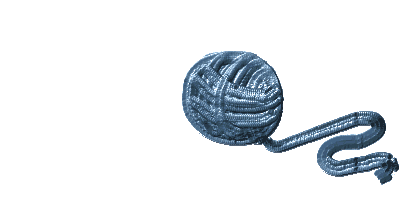Bavarian Sock
Pattern 
This pattern is a typical Bavarian-style
sock. The button is ornamental only; it is sewn on and there is no
buttonhole. You can use other types of ornaments such as pewter Edelweiss,
strips of suede, ribbons, or even a miniature Tyrolean-style cowbell.
Traditional colors are beige, loden green,
red, and gray.
Materials
100
g Ball Regia 6-Faden or 100 gm any sport weight yarn
Size
3 or 4 double-pointed needle set (2.25-to 2.75 mm) (I use a set of 5
needles; you can use 4 needles.)
2
ornamental buttons: Traditionally, horn buttons are used. You can also use
pewter buttons.
A heart-shaped button of horn is shown in the picture.
Optional:
strips of suede leather, ribbons to be sewn behind ornamental button.
Method:
Cast
on 60 stitches. DO NOT close the tube, but knit back and forth in 2X2 knit and
purl rib for about 3 inches. This makes the ornamental fold down cuff.
Now, close the tube and knit for 4 or 5 more inches; cuff is finished.
On
to the heel: Put half the stitches on hold on two needles (or one, if you use 4
and not 5 needles.) Put the other
30 stitches on a needle and knit back and forth for about 20 rows;
Row
1: K1, Sl, repeat; end on K1
Row
2: Purl
repeat,
end ready to do a Purl row.
Turn
heel:
P
across until you have 11 sts remaining, P2tog and turn. Slip that first st and
work across in pattern till you
have 11 sts remaining. SSK, turn, slip 1. Purl back across till you get to the
stitch before the "gap," P2tog, turn, slip 1. Work back across in the
slip pattern st until you get to the st before the gap
on this edge, SSK, turn and slip 1. Continue in this manner until all the edge
sts are eaten up - after you do the last SSK you should have 10 sts on the
needle and be ready to pick up the sts for the first side of the gusset.
Pick
up 19 sts down the heel flap. Knit across the 30 instep sts in plain knit. Pick
up the next 19 stitches on the other side of the flap for the gusset. K 1 round
plain.
Then,
knit up 17 of the first 19 stitches on the first gusset needle, k2tog, k1, knit
across the 30 instep stitches, then on the next gusset needle k1, ssk, knit to
end; one decrease round finished.
Alternate
the plain and decrease rounds until you are back to 60 total stitches. Knit down
to 2 1/2 inches before desired foot length (my foot is 9 inches long so I stop
at 6 1/2 inches.)
Now,
knit the toe:
Round
1. Knit to end of first (gusset or sole) needle: k2tog k1, then on instep, k1
ssk, knit to 3 stitches before end of the 30 instep stitches; k2tog k1. Then on
the next gusset (sole) needle, k1, ssk, knit to end.
Round
2 knit plain.
repeat
until 8 stitches remain on instep and 4 on each sole needle. Graft together
using Kitchener stitch:
put
the 8 sole stitches on one needle
put
the 8 instep stitches on another needle. Break off knitting wool, leaving at
least a foot of yarn.
Now,
slip front stitch as if to knit, slip off, slip next front needle stitch as if
to purl, leave on needle. Slip back needle stitch as if to purl, slip off, slip
next backstitch as if to knit, leave on. Repeat this as a mantra until all the
stitches are grafted.
WARNING!!!
When knitting the second sock, arrange the cuff so the button will fall on the
outside of your ankle (mirror image). Otherwise you will have two left or two
right socks.
Finishing:
Weave
in ends, sew on button and block. These socks are typically worn with
hiking boots, even under printed Dirndl skirts and dresses. A bandana-style
kerchief with a cowbell is often worn around the neck.
 Back to Home
Back to Home